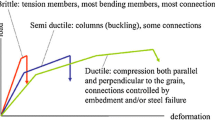Abstract
The strength of timber is significantly reduced under sustained load. Existing experimental data give a reasonable estimate of the strength reduction as a function of time under constant load. In practice, however, the load level is variable in time. For this situation the strength reduction must be estimated on the basis of so called damage theories.
In engineering design, effects of load duration are accounted for by a strength reduction factor, kmod, which depends on the type of load acting on the structure. The loads are classified in terms of their duration time. In a load combination the value of kmod is based on the load with shortest duration. For several reasons the scientific basis to determine kmod is rather uncertain.
In this paper a probabilistic analysis is made with the purpose to calibrate kmod for timber structures under combination of permanent load and snow load. The analyses are based on Swedish data for snow. A theoretical model proposed in [1] describes the damage accumulation. The analyses show that kmod is of the order 0.8 for geographic locations with heavy snow loads as well as for locations with moderate snow loads. The factor kmod was also found independent of the two practically relevant load combinations studied. The results can be used as recommendations for appropriate choice of kmod in engineering design.
Résumé
La résistance du bois de construction diminue significativement sous la pression de charge. Les données expérimentales qui existent, donnent une estimation raisonnable de la réduction de la résistance du bois comme étant une fonction du temps sous une charge constante. Dans la réalité, le niveau de charge est néanmoins variable dans le temps. Pour cette raison la réduction de la résistance doit être estimée sur la base de ce que l’on appelle la théorie des dommages.
En design de construction, les effets de la durée d’une charge sont représentées par un facteur de la réduction de la résistance, kmod, qui dépend du type de la charge pesant sur la structure. Les charges sont classifiées en terme de leur durée de temps. Lorsque les charges sont variables, la valeur kmod est basée sur la charge ayant la plus courte durée. Pour plusieurs raisons la base scientifique qui détermine kmod est assez incertaine.
Dans cet article, nous réalisons une analyse de probabilité ayant pour but de calibrer kmod en ce qui concerne le bois de construction subissant des combinaisons de charges permanentes et de charges neigeuses. Les analyses sont basées sur des données suédoises sur la neige. Un modèle théorique proposé [1] décrit. l’accummulation des dommages. Les analyses montrent que kmod est de l’ordre de 0,8 aussi bien dans les zones géographiques ayant de lourdes charges de neige que dans les zones ayant des charges modérées. Le facteur kmod se révèle donc être indépendant des deux principales combinaisons de charges étudiées. Ces résultats peuvent être utilisés comme recommandation pour le choix approprié de kmod en design de construction.
Similar content being viewed by others
References
Barrett, J. D. and Foschi, R. O., ‘Leutration of load and probability of failure in wood, part I and II’,Canadian Journal of Civil Engineering 5 (4) (1978) 505–532.
Thoft-Christensen, P. and Baker, M. J., ‘Structural Reliability Theory and Its Applications’, Springer-Verlag Berlin Heidelberg New York 1982).
Wood, L. W., ‘Behaviour of wood under continued loading’,Eng. News-Record 139 (24) (1947) 108–111.
Pearson, R. G., ‘The effects of duration of load on the bending strength of wood’,Holz Forschung 26 (4) (1972) 153–158.
Hoffmeyer, P., ‘Failure of Wood as Influenced by Moisture and Duration of Load’, (Collage of Environmental Sci. and Forestry. S.U.N.Y., Syracuse, N.Y., U.S.A. 1990).
Madsen, B. ‘Structural Behaviour of Timber’, (Timber Eng. Ltd, Vancouver, Canada, 1992).
Foschi, R. O., Folz B. R. and Yao, F. J., ‘Reliability Based Design of Wood Structures’, (Structural Research Series Report No. 34, UBC, Vanconver, Canada 1989).
BKR99. Boverkets konstruktionsregler., ‘Regulations of building design, by Swedish dept, of building’ only available in Swedish (BFS 1993: 58-Bfs 1998: 39. 1999).
Ditlevsen, O., ‘Codified reliability of structures’, in ‘Calibration of Partial Safety Factors’, (NKB [995, 02E 1995).
Forsler, S., Jonasson, H., Landin, W., Schärnell L. and Åkerlund, S., ’Snödjupioch vattenvärde’, ‘Snow Depth and Water Values’ only available in Swedish, (Rapport 24, Inst. för Byggnadsteknik, Lunds Tekniska Högskola, 1971).
Nielsen, L. and Kousholt, K., ‘Stress-strength-lifetime relationship for wood’,Wood Science and Tech 12 (1980).
Foschi, R. O. and Yao, F. J. ‘Another look at three duration of load models’, in CIB-W 18/19-9-1 Proceedings CIB-W 18/19-9-I. Florence, Italy, 1986.
Gerhards, C. and Link, C., ‘Effects of loading rate on bending strength of Douglas-fir 2 by 4’s’,Forest Prod. J. 36 (2) (1986) 63–66.
Forsythe, G. E., Mal olm, M. A. and Moler, C. B., ‘Computer Methods for Mathematical Computations’, (Prentice-Hall, 1976).
Thelandersson, S., Larsen, H. J., Östlund, L., Isaksson, T. and Svensson, S., ’Säkerhetsnivåer för trä och träbaserade produkter’, ‘Safety of wood and wood based products’ only available in Swedish, (Report TVBK 3035, Div. of Structural Engineering, Lund University, Sweden, 1999).
Author information
Authors and Affiliations
Additional information
Editorial Note Prof. H. J. Lorsen and Prof, S. Thelandersson are RILEM Senior Members This anide has been published in RILEM Proceedings International RILEM Symposium on Timber Engineering.
Rights and permissions
About this article
Cite this article
Svensson, S., Thelandersson, S. & Larsen, H.J. Reliability of timber structures under long term loads. Mater Struct 32, 755–760 (1999). https://doi.org/10.1007/BF02905072
Received:
Accepted:
Issue Date:
DOI: https://doi.org/10.1007/BF02905072




